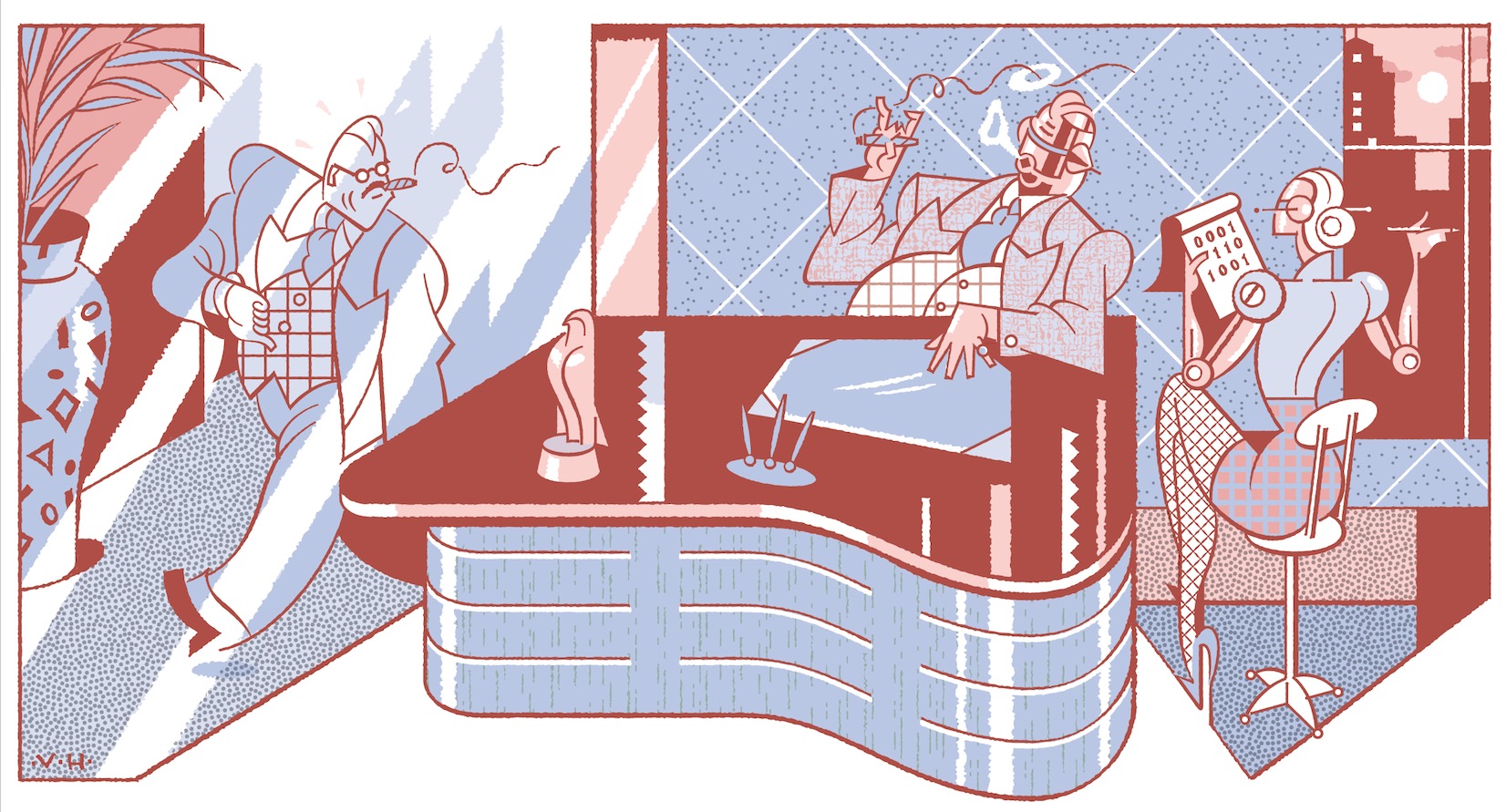Work Like a Machine
Will the rise of robots result in mass redundancy? Not really, argues Tom Cheshire, who suggests a future where man and machine are able to work in harmony

In the Hollywood version of humanity’s end, robots, red eyes aglow, gun us down in a hail of bullets. In real life, it’s more prosaic: the machines hand us a P45. The robots aren’t coming for us, they’re coming for our jobs. Foxconn, the electronics company which manufactures most of our devices, uses one million robots in its construction line. South Korea is trialling robot prison wardens.
In the US automotive industry, there is one robot for every 10 humans employed. Hackett Group, a process improvement and cost reduction consultancy, estimates that, by 2016, automation will have replaced more than two million jobs in Europe and the US. And although the US and the rest of the world has recovered from the recession, employment figures haven’t.
As two MIT researchers, Erik Brynjolfsson and Andrew McAfee observe: “Companies brought new machines in, but not new people.” Economist Tyler Cowen, the author of Average Is Over: Powering America Beyond the Age of the Great Stagnation, likes to reference a joke: “A modern textile mill employs only a man and a dog – the man to feed the dog, and the dog to keep the man away from the machines. That is the world in which we now live,” he says. The real-life punchline is even less funny: economists Jeffrey Sachs and Laurence Kotlikoff warn that “smart machines” could “engender long-term misery”.
It was ever thus, though. In 1779, a young weaver was whipped for his idleness; afterwards, in a fit of rage, he smashed two weaving frames. His hot-headedness inspired a movement, the followers of “King Ludd”, who, by this time, was reputed to live in Sherwood Forest. But the Luddites found themselves on the wrong side of history: during the Industrial Revolution, incomes and jobs grew at an unprecedented rate. Then 150 years later, in 1930, John Maynard Keynes worried about a “new disease”, the one of “technological unemployment... due to our discovery of means of economising the use of labour outrunning the pace at which we can find new uses for labour.” When Keynes wrote that sentence, US GDP was $92 billion; in 2013, it was $17 trillion. Although automation did lead to short-term job losses, these were made up in the rest of economy. Robots took care of the routine work, letting humans focus on the jobs that robots couldn’t handle: work that required adaptability and originality.
This new wave of automation seems to fit straight into that pattern. Fetching packages from the shelves of an Amazon warehouse is a dull, repetitive task; one warehouse manager actually described his employees as “sort of like a robot, but in human form”, so why not just get robots to do those jobs? Kiva, which Amazon acquired, also supplies its perky bright orange robots to retailers like Staples and Gilt Groupe. Robots in the US are used to count and process medications, dispensing pills more reliably and more cheaply than humans. A similar system in the UK has saved the Forth Valley Royal hospital in Larbert £700,000. “It’s reduced errors at the point of picking and dispensing so our staff are now able to work beside the patients, checking their medicines as they come into the hospital,” says the hospital’s lead pharmacist Jann Davidson.
So: robots do the boring but important jobs, humans get the fun stuff. Sounds good. The catch is, the new wave of “smart machines” – computers capable of processing complex real-world information, and even of learning for themselves – means that those jobs we once saw as quintessentially human are now at risk. According to The Future of Employment: How Susceptible Are Jobs to Computerisation?, a recent paper by Carl Benedikt Frey and Michael Osborne, two researchers working at the Oxford Martin School, Oxford University, 47% of all jobs, not just those in warehouses and factories, are at risk of being taken by robots.
Lawyers, insurance underwriters and sportswriters all stand a good chance of being replaced. Algorithms can write human-sounding business reports; hiring decisions can now be made by virtual avatars, not HR. Robots want to be white collar. Whatever your job, you’ll soon have to answer the question: are you smarter than the algorithms?
This is a worrying development. Humans were always meant to be better at the messy human business of pattern recognition. Only ten years ago, two MIT and Harvard economists stated that algorithms would never be able to match the tasks carried out by automobile drivers. Now, Google’s driverless cars have logged nearly half a million kilometres of road tests – without an accident. When IBM’s Deep Blue computer beat Garry Kasparov at chess less than 20 years ago, it was ominous, but there was some consolation in the fact that Deep Blue was crunching the numbers in a very mathematical game. But then Watson, Deep Blue’s successor, beat humans at their very own game, the odd American quiz show Jeopardy!, in 2011. Robots were now better at bad puns. And that’s with only today’s technology. Ray Kurzweil, the slightly cultish singularity advocate and directorof engineering at Google (who correctly predicted when a computer would beat a human), says machines will be more intelligent than humans by 2029. They’ll be funnier, wiser, (nicer?) and better at flirting than us. There will come a point where you’d rather invite robots to your dinner parties than slow-witted meatsacks. They’ll bring better wine, too.
When most of our jobs are under threat of automation, Luddism would become a reasonable majority opinion. We’re starting to see the modern equivalent, as French taxi drivers physically attack the vehicles run by pre-booking service Uber, a driver service app whose usefulness derives from its matching algorithms. But a fight is a bad idea – we’ll lose. As Brynjolfsson and McAfee write in their book Race Against the Machine: “We can’t win that race, especially as computers continue to become more powerful and capable. But we can learn to better race with machines, using them as allies rather than adversaries.”
Despite Kasparov’s humbling, the best chess player isn’t a computer. Nor is it a human. It’s a computer/human team: a grandmaster and computer paired together routinely beat the most advanced chess robots. These combinations – the WIRED columnist Clive Thompson them calls “centaurs” in his book Smarter Than You Think – are the future of work. IBM’s Watson wasn’t just expensive proof of concept: it’s now being used in cancer diagnostics and is better than human doctors at spotting cancer. Doctors aren’t taking a wrench to Watson, because it saves people’s lives and makes their jobs easier; working with computers, they can focus on the other aspects crucial to their jobs, especially human care. The Frey and Osborne paper stating that 47% of jobs were at robot risk also listed those least likely to be automated; they include occupational therapy, social working, firefighting, and (gratifyingly, for this correspondent) editing.
This means we need to recalibrate. We need to focus now on teaching our younger generations the skills useful for working with machines. This doesn’t mean coding and engineering, although neither is a bad thing. Instead, we should be thinking about what humans can bring that robots still aren’t so good at (at least until 2029, if Kurzweil is right) – interactivity, emotional intelligence, flexibility, quirkiness – and emphasise those traits through training. This can be done at the school level, combining foundational skills with very specific vocational skills, creating a class of what Harvard economist Lawrence Katz calls “the new artisans”. Every wave of automation, from the abacus onwards, has actually helped refine the question: what is it that humans are particularly good at? We’ll soon find out.


